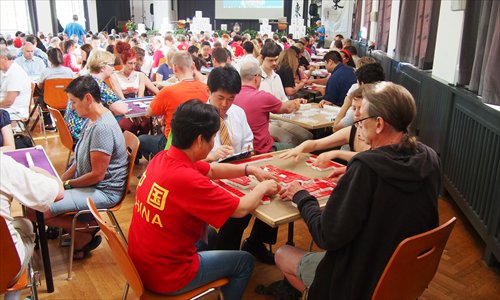

Mahjong players from around the world test their mettle at this year's 5th European Mahjong Competition, held in Strasbourg, France. Photo: Courtesy of Tina Christensen
More foreigners are playing than ever, and they are beating the Chinese at their own game
It is a familiar scene in many a card parlour or street corner in Beijing. Old men, hairs graying or gone and bellies protruding crowded around a rectangular board. The clattering of plastic tiles with Chinese characters scrawled on them. Sweat dripping precipitously from their brows, an expression of stern concentration as they puff nervously on their cigarettes. And then the bursting of the dam, the cackling of laughter and gloating or complaints made in indignation and self-reprimand.
But in this particular crowd of mahjong players is something slightly less familiar: a ruddy-cheeked young Englishman of impressive girth, by the name of Charles de Pellette. A 24-year-old student who grew up in Hong Kong, de Pellette moves the tiles about the board with the deftness of an old hand.
"I have memories of seeing old Chinese men in Kennedy town in Hong Kong, sitting outside and playing mahjong late into the night," said de Pallette, recalling his childhood. "[They moved the tiles about] so quickly. It was almost unbelievable they could even see [them]."
Traditionally a game for Chinese scholars, with some even suggesting that it was invented by Confucius, mahjong has developed a following around the world. Although there are dozens of regional variations, the basic rules of mahjong are as follows. There are 144 tiles made up of various symbols, pictograms, and Chinese characters. A standard game has four players, with each player beginning with 13 tiles. Over a series of rounds, players discard, steal, or pick up new tiles, with the objective of forming combinations of three or more tiles (called "melds"), as in Rummy or Canasta. The game ends when any player chooses to pick up another player's discarded tile, in order to form a finishing "pair" in addition to the sets he or she has made, giving the player a final hand of 14 tiles.
"The way that tiles are put together [to form sets], with three of a kind or straights, makes it similar to a card game called Gin Rummy that we play in England," said de Pallette.
Though it is still not usual to see foreigners huddled playing mahjong in the hutong, it is not as unusual as some might think.
This year, the 5th European Mahjong Competition was held in Strasbourg, France, over three days in July. Given that the game originated in China, and boasts by far the largest number of casual players, it would be reasonable to expect that the Chinese contingent would clean up the competition. But in a stunning turn of events, the top three place getters were players from Germany and Japan. The two Chinese entrants finished 37th and 39th.
Not only has the rest of the world started playing mahjong, they are beginning to beat China at its own game.
Foreign experts
Although there are few professional players of mahjong in China or around the world, the number of serious casual players around the world has increased significantly in recent years, said Yao Xiaolei, the assistant secretary-general of the World Mahjong Organization(WMO) and team leader at the recent European championships.
According to Yao, foreign players tend to be younger and university-educated, while Chinese players are largely made up of people in their 50s and 60s, hailing from all walks of life.
"I'm quite surprised by how quickly the foreign players have improved," remarked Yao. "They know the rules inside out, and are able to adhere to them strictly. They even know how to call 'chi, peng, gang, hua, hu' [calls that players must announce when they hold a particular combination of cards]. Their pronunciation of the Chinese characters is not bad at all!"
According to Tina Christensen, president of Mahjong Denmark and the European Mahjong Association (EMA), the popularity of mahjong has grown enormously in Europe over the past decade.
Christensen was introduced to the game when the uncle of a friend brought back a set of mahjong tiles from China in 1998. She started playing in earnest with other students at University of Aarhus in Denmark, and two years later, along with other fellow mahjong enthusiasts, she formed Mahjong Denmark, the first national mahjong association in Europe.
The EMA was established five years later, in 2005. By then, there was already a small community of avid mahjong players organizing informal local tournaments, especially in the Netherlands and Italy, according to Christensen.
At present, the EMA has 19 member countries, with 540 ranked players who have attended elite competitions run by the WMO.
"I see people playing mahjong outside China all the time, and I play at least once a week in Copenhagen, Denmark," said Christensen. "I play several tournaments in Europe every year, and this year, I played [a tournament] in Japan as well."
Copyright ©1999-2018
Chinanews.com. All rights reserved.
Reproduction in whole or in part without permission is prohibited.